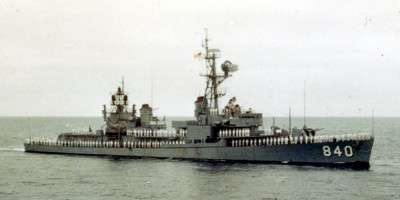
Some Fletchers were brought out of mothballs, modified and redesignated escort destroyers (DDEs) to carry these systems, but because they lacked sufficient internal room, the modification program was halted in favor of the development of specialized anti-submarine warfare (ASW) escorts, although many of them continued in an anti-submarine role even after redesignation as DDs in the sixties.

Gearing-class Glennon, following FRAM conversion, renders honors off Ecuador in 1967.
Meanwhile, ships of the Allen M. Sumner and Gearing classes, which had not been decommissioned following World War II, remained in service as the new Forrest Sherman class began to join the fleet. One of the Gearings, Gyatt (DD 712), was temporarily converted to carry missiles in place of her after 5-inch gun mount and designated DDG 1, the US Navy’s first guided missile destroyer.
Not all Fletchers were returned to service in the fifties; some went to foreign navies (later followed by Sumners and Gearings). Many of those that did enjoyed long and useful US Navy careers, however—some extended by Fleet Rehabilitation and Modernization (FRAM) programs. Decommissionings from US Navy service lingered into the 1970s and in foreign navies until the end of the century and beyond.